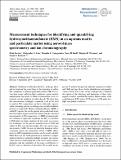Measurement techniques for identifying and quantifying hydroxymethanesulfonate (HMS) in an aqueous matrix and particulate matter using aerosol mass spectrometry and ion chromatography
Author(s)
Dovrou, Eleni; Lim, Christopher Yung-Ta; Canagaratna, Manjula R.; Kroll, Jesse; Worsnop, Douglas R.; Keutsch, Frank N.; ... Show more Show less
DownloadPublished version (1.054Mb)
Publisher with Creative Commons License
Publisher with Creative Commons License
Creative Commons Attribution
Terms of use
Metadata
Show full item recordAbstract
Oxidation of sulfur dioxide (SO2) in the gas phase and in cloud and fog water leads to the formation of sulfate that contributes to ambient particulate matter (PM). For severe haze events with low-light conditions, current models underestimate the levels of sulfate formation that occur exclusively via the oxidation of sulfur dioxide. We show here that measurement techniques commonly used in the field to analyze PM composition can fail to efficiently separate sulfur-containing species, resulting in the possible misidentification of compounds. Hydroxymethanesulfonate (HMS), a sulfur(IV) species that can be present in fog and cloud water, has been largely neglected in both chemical models and field measurements of PM composition. As HMS is formed without oxidation, it represents a pathway for SO2 to contribute to PM under low-light conditions. In this work, we evaluate two techniques for the specific quantification of HMS and sulfate in PM, ion chromatography (IC) and aerosol mass spectrometry (AMS). In cases in which the dominant sulfurcontaining species are ammonium sulfate or HMS, differences in AMS fragmentation patterns can be used to identify HMS. However, the AMS quantification of HMS in complex ambient mixtures containing multiple inorganic and organic sulfur species is challenging due to the lack of unique organic fragments and the variability of fractional contributions of HxSO+y ions as a function of the matrix. We describe an improved IC method that provides efficient separation of sulfate and HMS and thus allows for the identification and quantification of both. The results of this work provide a technical description of the efficiency and limitations of these techniques as well as a method that enables further studies of the contribution of S(IV) versus S(VI) species to PM under lowlight atmospheric conditions.
Date issued
2019-10Department
Massachusetts Institute of Technology. Department of Civil and Environmental EngineeringJournal
Atmospheric Measurement Techniques
Publisher
Copernicus GmbH
Citation
Dovrou, Eleni, et al. "Measurement techniques for identifying and quantifying hydroxymethanesulfonate (HMS) in an aqueous matrix and particulate matter using aerosol mass spectrometry and ion chromatography." Atmospheric Measurement Techniques, 12 (2019): 5303-5315. © 2019 Author(s). This work is distributed under the Creative Commons Attribution 4.0 License.
Version: Final published version
ISSN
1867-8548